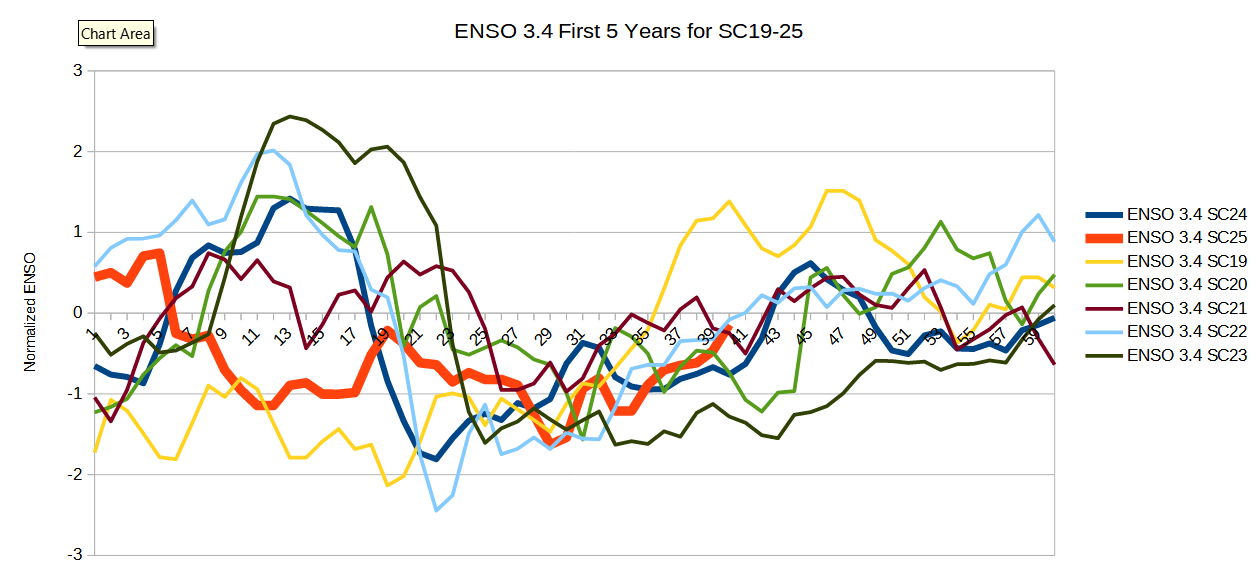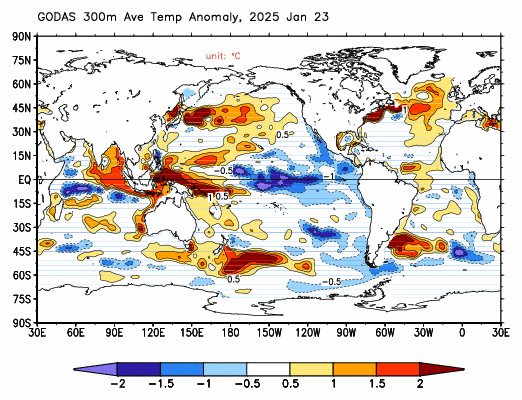|
|
Post by ratty on Apr 10, 2023 1:18:40 GMT
|
|
|
|
Post by Sigurdur on Apr 21, 2023 21:09:03 GMT
|
|
|
|
Post by duwayne on Apr 24, 2023 19:40:04 GMT
I've noted previously that the IRI ENSO predictions have been pretty bad on past occasions. The current predictions in the chart below are grouped into 2 categories, Dynamical Models and Statistical Models which are charted in heavy green and heavy blue lines respectively. There is also a heavy maroon line labeled CPC CONSOL which I believe is largely based on statistical models. The Dynamic models are the ones which have the really poor past performance.
Dynamic Models are based on physics equations and projections thereof. Statistical Models look at the actual results from similar past situations and make projections by selecting from past statistics.
The projections that Missouriboy and I have made concerning ENSO over the next several months are statistical models based on historical values for situations which we believe are similar to the current conditions and the predictions are similar to the lower values from the statistical models on the IRI chart above. These projections can certainly be wrong and the dynamic models might be right this time.
I bring this up because I find that the while dynamic models work sometimes, they don't seem to worked that well for ENSO, Sunspots, or climate change. Statistical models seem to have worked much better. Yet scientists insist on pushing their Dynamic Model predictions on us.
In additon to the Dynamic Model failures with ENSO, compare Svalgaards's statistically based sunspot number maximum predictions to others based on Dynamic Models. Compare my statistically-based global temperature predictions from 15 years ago to the "experts" with their Dynamic weather model predictions.
My point is not that statistical models are always right. In fact, over this past month El Nino's chances have picked up. It is that dynamic models are often wrong and in these cases specific statistical models may be the better tool.
|
|
|
|
Post by missouriboy on Apr 24, 2023 21:38:51 GMT
I've noted previously that the IRI ENSO predictions have been pretty bad on past occasions. The current predictions in the chart below are grouped into 2 categories, Dynamical Models and Statistical Models which are charted in heavy green and heavy blue lines respectively. There is also a heavy maroon line labeled CPC CONSOL which I believe is largely based on statistical models. The Dynamic models are the ones which have the really poor past performance.
Dynamic Models are based on physics equations and projections thereof. Statistical Models look at the actual results from similar past situations and make projections by selecting from past statistics.
The projections that Missouriboy and I have made concerning ENSO over the next several months are statistical models based on historical values for situations which we believe are similar to the current conditions and the predictions are similar to the lower values from the statistical models on the IRI chart above. These projections can certainly be wrong and the dynamic models might be right this time.
I bring this up because I find that the while dynamic models work sometimes, they don't seem to worked that well for ENSO, Sunspots, or climate change. Statistical models seem to have worked much better. Yet scientists insist on pushing their Dynamic Model predictions on us.
In additon to the Dynamic Model failures with ENSO, compare Svalgaards's statistically based sunspot number maximum predictions to others based on Dynamic Models. Compare my statistically-based global temperature predictions from 15 years ago to the "experts" with their Dynamic weather model predictions.
My point is not that statistical models are always right. In fact, over this past month El Nino's chances have picked up. It is that dynamic models are often wrong and in these cases specific statistical models may be the better tool.
Right in line with the new geology approach over the last 5 decades, which was a break with uniformitarianism (the present is the key to the past). The "dynamic modelers" have an end in mind already.
Mark Twain: It Ain’t What You Don’t Know That Gets You Into Trouble. It’s What You Know for Sure That Just Ain’t So.
The past is the key to the future
January 1, 1983
A new major frontier of geological research, which was initiated in the 1970's, involves predicting future geologic trends or events through study of the present and past, rather than trying to understand the past, often using what one knows about the present. Like most scientific frontiers, this one began from practical considerations-environmental concerns. The lack of formal recognition of this frontier results from fragmentation among many Federal agencies and highly focused mission-oriented programs (e.g., earthquake prediction, CO2, nuclear-energy safety, etc.). Most programs aim to predict only the next 50-100 years, but much longer periods of the past need to be studied to do this. Nuclear-waste disposal has sometimes been considered in terms of the next million years, a period of time permitting significant and broad geologic changes. Decreasing public interest in environmental concerns relegates many questions from the realm of applied research back to that of basic research. Most of these questions are so fascinating, however, that the frontier is still worth pursuing. Such questions include whether a phenomenon will or will not take place and the rates at which it can develop (e.g., how fast do rifts form, how fast can a caldera event begin, and how quickly can a glacial maximum arrive?). Common elements of all studies include the historic record, trends in the Quaternary, analogues in various periods of the geologic time scale, and allowance for phenomena never experienced before. Other examples of studies include the Cretaceous as a period of a climatic extreme, an especially interesting time period; establishing the amount of paleocloudiness, a particularly challenging and important research area; acid rain as a possible new phenomenon. Geochemistry has much to contribute to this frontier science. ?? 1983.
|
|
|
|
Post by missouriboy on Apr 29, 2023 17:57:28 GMT
Is this a result of the warm waters along the SA coast? My alarm bells suggest yes.
|
|
|
|
Post by missouriboy on Apr 30, 2023 20:53:37 GMT
There is a full court press going on regarding a monster ENSO building for this year. The following chart shows ENSO 3.4 values for the first 5 years (60 months) of solar cycles 19 to 25. The only REAL El Nino (SSTA values above 0.5 for a minimum of 3 months) occurring in the 4th year of the last 7 solar cycles occurred in Solar cycle 19. It was a long one in a large cycle. Solar Cycle 24 almost made a weak one, but it was only 2 months above 0.5. Solar cycles 20 and 22 had El Ninos in the 5th year of the cycle. They are beating the drums really hard, but have offered no explanations for why this cycle should be different than past cycles in year 4.
 |
|
|
|
Post by ratty on May 1, 2023 0:51:51 GMT
That's a work of art, Missouri! Have you specified a recipient for all your data in you will?  |
|
|
|
Post by missouriboy on May 1, 2023 1:15:03 GMT
That's a work of art, Missouri! Have you specified a recipient for all your data in you will?  I had considered leaving it to the Italian Spaghetti Gallery. Or ... the Wiggle Watchers Institute.  |
|
|
|
Post by ratty on May 1, 2023 1:25:41 GMT
That's a work of art, Missouri! Have you specified a recipient for all your data in you will?  I had considered leaving it to the Italian Spaghetti Gallery. Or ... the Wiggle Watchers Institute.  Why, thank you! I'm its President.  |
|
|
|
Post by missouriboy on May 1, 2023 21:11:17 GMT
|
|
|
|
Post by duwayne on May 1, 2023 23:29:02 GMT
The weekly BOM ENSO reading rose to 0.45 this week closing in on the 0.5 El Nino level.
Meanwhile the SOI, averaged near zero for the last 30 days and is still near zero which indicates westerly winds in the ENSO area at the equator are near normal.
Why is ENSO up when the SOI is near zero? Low SOI’s, that is weak westerly winds, are the general cause of high ENSO’s and El Nino’s. Weak westerly winds (negative SOI’s) inhibits upwelling of cold water off the coast of South America and this lack of cooling means a warmer surface in the ENSO area.
The likely cause of the increased ENSO readings is the recent downwelling equatorial Kelvin Wave which in itself isn’t indicative of a coming El Nino. Just the end of the La Nina.
If you watch the ocean at the 180 degree line on the equator on the video below you’ll see a gush of warm water rolling to the east.
 The warm water had been stacked up in the west by the strong westerly winds as documented by a long period of high SOI’s. When the wind fell back to normal the stacked water cascaded back to the east in a downwelling Kevin wave.
Equatorial Kelvin waves stay near the equator because the westerly winds in addition to blowing west push towards the equator due to the coriolis effect from the earth’s spin.
This chart shows the recent history of the Kelvin wave.
Kelvin waves come and Kelvin waves go. Once the current wave is completed ENSO temperatures should move back towards normal unless the SOI moves down significantly from zero. The SOI well could drop in the future leading to a true El Nino. But it's not obvious why this will happen in the coming 6 months. |
|
|
|
Post by missouriboy on May 2, 2023 3:05:13 GMT
Agreed. I note the strong negative IOD that developed over the last two years. This resulted in warmer water concentrations in the Western Warm pool, north and northeast of Australia ... some of which may have fueled the eastward moving gravity wave.
|
|
|
|
Post by ratty on May 10, 2023 22:22:18 GMT
|
|
|
|
Post by blustnmtn on May 11, 2023 1:13:49 GMT
Classic Confirmation Bias.
|
|
|
|
Post by phydeaux2363 on May 11, 2023 16:15:31 GMT
Re:: Mr. Rat's post. is there nothing these guys won't blame on humans? Are they so arrogant that they really believe humans control every input into the complex non-linear, chaotic climate system? Or is it as Mr. blust says, "confirmation bias."
Inquiring minds want to know.
|
|